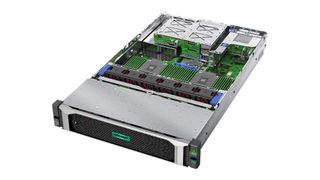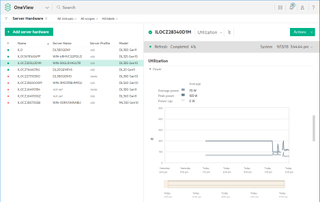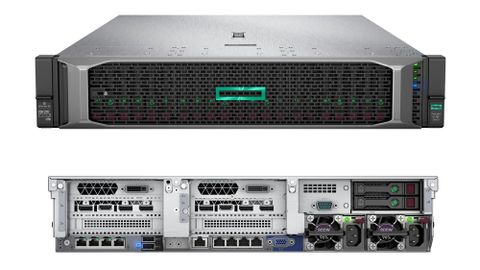IT Pro Verdict
A cracking 2P AMD EPYC rack server that delivers CPU cores, memory and storage in abundance at a price both SMBs and enterprises will find very appealing
Pros
- +
Super value; Classy design; Dual AMD EPYCs; 4TB of memory; Flexible storage options; Big expansion potential
Cons
- -
Mid-plane LFF tray limits CPU choice
Targeting memory-intensive workloads and virtualization duties, HPE's ProLiant DL385 Gen10 is one of the most flexible rack server packages we've yet seen. Support for dual AMD EPYC CPUs takes the core count up to 64 while its maximum 4TB of memory allows HPE to claim this 2U rack server offers the lowest cost per virtual machine (VM).
Businesses with storage-centric workloads will find a lot to like here as well. The DL385 Gen10 offers a remarkable range of storage options as it can support 24 PCIe NVMe SSDs, 30 SFF HDDs or even up to 19 LFF HDDs.
HPE has also introduced its 'Top Value' program which allows SMBs to match server hardware packages to their budget and groups models into entry, performance and solution categories. The entry model 878712-B21 has a low price of 1,524, which gets you an 8-core 2.1GHz AMD EPYC 7521, 16GB of DDR4, an 8-bay LFF drive cage, a Smart Array E208i-a SR RAID card and a 500W PSU.
On review, we have the performance model 878720-B21 which has a meatier 24-core 2GHz AMD EPYC 7401. This is partnered by 32GB of DDR4, a full house of 24 SFF drive bays, a Smart Array P408i-a RAID card and one 800W PSU.

HPE ProLiant DL385 Gen10: Storage
ProLiant servers generally don't include any storage devices in their base price and it's worth taking some time to research the multitude of choices. Entry models start with an 8-bay LFF drive cage or you can choose a 12 LFF bay version instead.
The drive count can be boosted further with a 4 LFF mid-plane tray which sits over the CPUs, replaces the plastic air shroud and requires the high performance fan kit. However, due to reduced airflow, the tray introduces a 125W TDP restriction which limits you to the 120W 8-core EPYC 7251.
Alternatively, you can install both dual-drive and single-drive cages at the rear giving you up to 15 LFF drives. For SFF drives, HPE's standard 8+8+8 drive bay box configuration gives you room for 24 drives at the front, which can be pushed to 30 with three rear dual-bay cages.
The server supports multiple configurations of NVMe SSDs, and those with deep pockets can specify all three boxes for a full house of 24. These also require the high performance fan kit and are cabled to the motherboard's dual embedded PCIe ports and three dedicated rear riser cards.
All models come with an onboard S100i Smart Array controller which is now tasked with managing the newly introduced dual embedded M.2 SATA SSD slots. These support 2280 and 22110 card sizes and can be used as a mirrored storage repository for your OS.

HPE ProLiant DL385 Gen10: Interior design
Measuring only 730mm deep, the DL385 Gen10 offers a well-designed and surprisingly spacious interior. The CPUs are topped with chunky passive heatsinks and flanked by a total of 32 DIMM slots which support up to 2TB with HPE's latest 64GB RDIMMs, or 4TB of LRDIMM memory.
We have HPE's SAS3 P408i-a Gen10 snap-in RAID module, which offers RAID5, 6, 50 and 60 arrays. It also includes 2GB of flash-backed write cache (FBWC) protected by a 96W high performance Li-Ion battery.
There's room for three PCIe risers for a total of 8 slots, but you won't need them for network upgrades; the server has four embedded Gigabit ports and a FlexibleLOM slot for dual- and quad-port 10GbE or dual-port 25GbE modules. The server also supports up to three double-width or five single-width GPU cards.
The price includes one 800W Platinum PSU with room for a second redundant supply alongside and HPE also offers 500W and 1600W Platinum versions. We found power consumption remarkably low with the review system drawing only 61W in idle and peaking at a mere 179W with its EPYC 7401 CPU under maximum load.

HPE ProLiant DL385 Gen10: Security and management
Platform security is tight with the iLO5 Secure Start validating the server's firmware using HPE's Silicon Root of Trust fingerprinting. This feature links up with AMD's integral Secure Processor hardware for pre-boot firmware validation and the EPYC SoC (system on chip) also provides server memory encryption along with options to securely encrypt VMs.
The iLO5 Standard license includes active system ROM validation and, if required, will activate the redundant system ROM. Should both ROMs fail validation, the Advanced Premium Security Edition license runs a firmware scan and repair process and can also run daily system firmware validations.
Remote management is top notch. The iLO5 web console is packed with information about the server's status and provides direct links to HPE support. It isn't as pretty as Dell EMC's iDRAC9 but it provides all essential details about critical components while the Advanced and Essentials licenses enable power metering, full OS remote control and virtual media services.
With the server's iLO5 details added to the lab's virtualized Hyper-V OneView app, we could keep an eye on CPUs, power usage and temperatures, control power and run remote control sessions. Enterprises will like HPE's new (and free) iLO Amplifier Pack VMware app which provides a web management console for discovery and inventory of up to 10,000 Gen8, Gen9 and Gen10 servers.
HPE ProLiant DL385 Gen10: Verdict
The ProLiant DL385 Gen10 is a highly flexible 2U rack server and its massive EPYC core count and big memory capacity make it an ideal virtualization candidate. Platform security is assured, build and design are exemplary, value looks good and it offers more storage permutations than you can shake a stick at.
Verdict
A cracking 2P AMD EPYC rack server that delivers CPU cores, memory and storage in abundance at a price both SMBs and enterprises will find very appealing
Chassis: 2U rack
CPU: 2GHz 24-core AMD EPYC 7401 (max 2)
Memory: 32GB 2,666MHz DDR4 SmartMemory (max 4TB with LRDIMM)
Drive bays: 24 x hot-swap SFF (max 30)
RAID: HPE Smart Array P408i-a SAS3/2GB with FBWC/BBU
Array support: RAID0, 1, 5, 6, 10, 50, 60, 1 ADM, 10 ADM
Expansion: 3 x PCI-e Gen3 slots (max 8)
Network: 4 x Gigabit
Other: FlexibleLOM, 2 x internal USB 3, microSD, 2 x M.2 SATA SSD
Cooling: 4 x hot-swap fans (max 6)
Power: 1 x 800W Platinum hot-plug PSU (max 2)
Management: HPE iLO5 Standard with Gigabit
Warranty: 3yrs on-site NBD
Dave is an IT consultant and freelance journalist specialising in hands-on reviews of computer networking products covering all market sectors from small businesses to enterprises. Founder of Binary Testing Ltd – the UK’s premier independent network testing laboratory - Dave has over 45 years of experience in the IT industry.
Dave has produced many thousands of in-depth business networking product reviews from his lab which have been reproduced globally. Writing for ITPro and its sister title, PC Pro, he covers all areas of business IT infrastructure, including servers, storage, network security, data protection, cloud, infrastructure and services.



